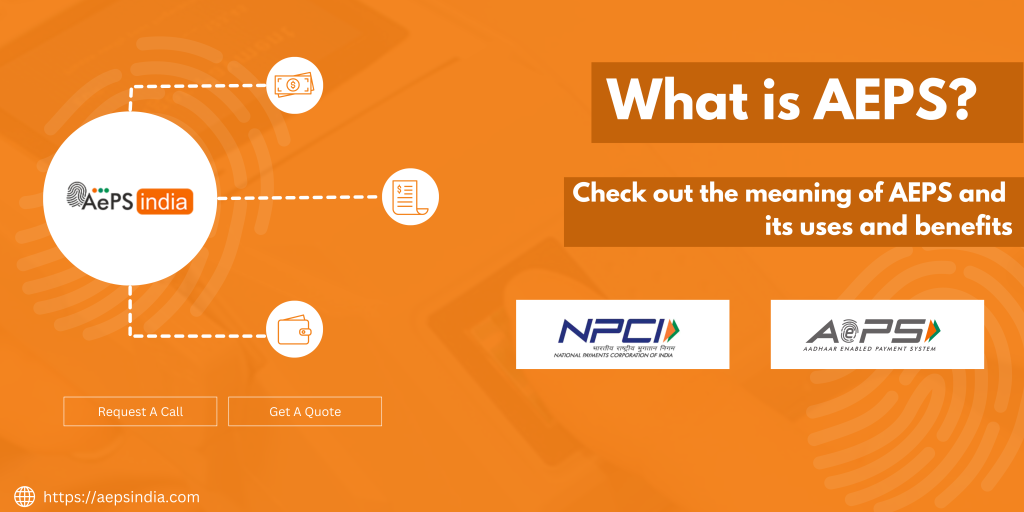What is AEPS and How Does It Work in India?
Aadhaar Enabled Payment System (AEPS) is a bank-led payment model developed by the National Payments Corporation of India (NPCI) that allows individuals to perform various financial transactions using their Aadhaar number and biometric authentication. It enables online, interoperable financial transactions at Point of Sale (PoS) devices, micro ATMs, or kiosks through authorized Business Correspondents (BCs) or Bank Mitras, facilitating services like cash withdrawals, deposits, balance inquiries, fund transfers, and mini statement requests.
The system is designed to promote financial inclusion by providing banking services to people in remote areas where traditional bank branches are unavailable, allowing users to access their Aadhaar-linked bank accounts without needing a debit card, smartphone, or internet connection.
AEPS is a key initiative by the Government of India and the Reserve Bank of India to support a cashless economy and ensure secure, convenient, and accessible digital payments for all citizens.
With platforms like aepsindia, individuals and businesses can leverage AEPS provide smooth, fast, and reliable transactions. AEPS services help retailers, agents, and banking correspondents manage digital payments efficiently while promoting financial inclusion across the country. Whether you are looking for an AEPS portal provider, AEPS B2B software, or a complete AEPS solution, understanding AEPS is the first step toward modern, secure banking.
You need to seed your account with your Aadhaar number at the bank or with the help of a banking correspondent to do transactions using AEPS. AEPS allows bank-to-bank transactions at PoS (MicroATM).
If you are looking for What is Aeps, how AEPS works, benefits, and simple steps to use it in India, you are in the right place.

What is Aeps
AEPS full form Aadhaar Enabled Payment System is a payment service by the National Payments Corporation of India (NPCI) that allows bank account holders to perform basic financial transactions at micro-ATMs using their Aadhaar number and biometric authentication (like fingerprints). This bank-led model enables services such as cash withdrawal, balance inquiry, cash deposit, and fund transfers between Aadhaar-linked accounts, promoting financial inclusion without needing debit cards or smartphones.
Common AEPS Transactions Balance Enquiry, Cash Withdrawal, Cash Deposit, Aadhaar to Aadhaar Fund Transfer, and Mini Statement.
Key Features & Benefits
- Financial Inclusion: Bridges the gap in financial access by providing banking services in remote areas through business correspondents.
- Simplicity:
- Easy to use, requiring only an Aadhaar number and biometric authentication.
- Security:
- Transactions are secured by biometric authentication, making them safe and reducing fraud.
- Government Benefits:
- Facilitates the disbursement of government entitlements and welfare schemes directly to beneficiaries.
- No Card/Internet Needed:
- Customers do not need a physical debit/credit card or a smartphone for transactions.
How Does AEPS Work?
AEPS mean Aadhaar Enabled Payment System is a bank-led model by the National Payments Corporation of India (NPCI) that enables people to perform financial transactions using their Aadhaar number and biometric authentication at a micro-ATM. To use AEPS, a customer visits a business correspondent’s micro-ATM provides their Aadhaar number, selects a transaction type, and then authenticates their identity with a fingerprint or iris scan. After successful authentication, the system processes the transaction, and a receipt is provided.
How AEPS Works: A Step-by-Step Guide
1. Visit a Business Correspondent: Go to a local bank agent or a retail outlet that has a micro ATM device.
2. Provide Details: Give the business correspondent your Aadhaar number and the name of your bank.
3. Choose Transaction Type: Select the type of financial transaction you want to perform, such as:
- Cash withdrawal
- Cash deposit
- Balance inquiry
- Mini statement
- Aadhaar to Aadhaar fund transfer
4. Biometric Authentication: You’ll be asked to authenticate your identity by providing a fingerprint or iris scan at the micro-ATM.
5. Aadhaar Verification: The system verifies the fingerprint against the Aadhaar database to authenticate the customer’s identity.
6. Transaction Processing: Once your identity is confirmed, the request is securely sent to the bank’s server for processing.
7. Receive Confirmation: If the transaction is successful, the business correspondent will dispense the cash or process the request, and you will receive a receipt for the transaction.
Key Benefits
- Financial Inclusion: AEPS provides access to basic banking services for people in rural areas who may not have access to bank branches.
- No Card/Smartphone Needed: You don’t need a debit card or smartphone to use the system.
- Government Entitlements: It facilitates the direct disbursement of government benefits like pensions and social security.
- Security: Transactions are secured through Aadhaar-based biometric authentication.
How to Use AEPS
To use Aadhaar Enabled Payment System (AEPS), find a micro-ATM or banking agent, provide your Aadhaar number, select your transaction type (e.g., cash withdrawal, balance inquiry), and then authenticate with a fingerprint or iris scan to complete the transaction. AEPS provide secure, cardless, and PIN-less banking services at the doorstep of customers.
Steps to Use AEPS
- Find an AEPS Outlet: Visit a Aepsindia website that provides AEPS services, often equipped with a micro-ATM.
- Provide Your Aadhaar Number: Inform the agent of your 12-digit Aadhaar number, which is linked to your bank account.
- Select Transaction Type and Bank: Choose the service you want, such as cash withdrawal, cash deposit, fund transfer, or balance inquiry, and specify your bank name.
- Enter Transaction Amount: Specify the amount for the transaction, if applicable (e.g., for cash withdrawal or deposit).
- Biometric Authentication: Authenticate your identity by placing your fingerprint or performing an iris scan on the biometric scanner.
- Receive Confirmation: Upon successful authentication and completion of the transaction, you will receive a printed receipt and an SMS confirmation.
AEPS Services in India
AEPS (Aadhaar Enabled Payment System) is a payment method in India that allows customers to conduct basic banking transactions using their Aadhaar number and biometric authentication, rather than physical cards. Supported by the National Payments Corporation of India (NPCI), AEPS uses Business Correspondents (BCs) and micro-ATMs to provide services like cash withdrawal, balance inquiry, and mini-statements, promoting financial inclusion for the unbanked and underbanked populations across India.
Services Offered by AEPS
- Cash Withdrawal: Customers can withdraw cash from their bank accounts.
- Balance Enquiry: Users can check their account balances.
- Mini Statement: A summary of recent transactions can be obtained.
- Cash Deposit: Cash can be deposited into linked bank accounts.
- Aadhaar to Aadhaar Fund Transfer: Fund transfers can be made from one Aadhaar account to another.
Who Can Use AEPS?
Any Indian resident with an Aadhaar-linked bank account can use AEPS for financial transactions by authenticating their identity with their biometric data. This system, facilitated by the National Payments Corporation of India (NPCI), allows customers to perform transactions such as cash withdrawals, deposits, and balance inquiries through participating banks’ Business Correspondents (BCs) or micro-ATMs.
Requirements for AEPS Users:
- Aadhaar Number: You must possess a valid Aadhaar number.
- Linked Bank Account: Your bank account must be linked to your Aadhaar number.
- Biometric Data: Your Aadhaar biometric data (fingerprints or iris scan) is required for authentication.
- Participating Bank: The bank where you hold the account must be part of the AEPS network.
- Access to Micro-ATMs: You need to visit a Business Correspondent (BC) or micro-ATM that supports AEPS.
How AEPS Works for Customers:
- Visit a BC/Micro-ATM: Go to an authorized BC or a micro-ATM.
- Select Transaction Type: Choose the aeps service you need, such as cash withdrawal or balance inquiry.
- Authenticate with Biometrics: Provide your biometric details (fingerprint or iris scan) for authentication.
- Complete the Transaction: The transaction is completed through the Aadhaar authentication gateway using your linked bank account.
Who Benefits from AEPS?
- Bank Account Holders: Any resident of India with an Aadhaar-linked bank account can use this service for basic banking needs.
- Beneficiaries of Government Schemes: AEPS facilitates the direct disbursement of government entitlements like social security pensions and MGNREGA payments to beneficiaries in remote areas.
- Individuals in Remote Areas: It brings essential banking services to underserved regions through micro-ATMs and BCs.
AEPS Fees and Charges
AEPS fees vary, but typically include charges for transactions beyond a free limit, with fees generally ranging from Rs. 5 to Rs. 20 plus GST per transaction for financial services like cash withdrawal and deposit. While the UIDAI doesn’t impose charges, banks and their Business Correspondents (BCs) set their own fees, often allowing a certain number of free transactions per month before charges apply.
Key Factors Influencing AEPS Fees
- Company Policy: Each Aepsindia company that offers AEPS services has its own fee structure.
- Transaction Type: Financial transactions (cash withdrawal, deposit, fund transfer) are usually more expensive than non-financial ones (balance enquiry, mini statement).
- Free Limits: Many banks offer a limited number of free transactions (e.g., three or four per month).
- GST: Applicable Goods and Services Tax is added to the transaction fee.
- Switching Fees: The National Payments Corporation of India (NPCI) levies a small switching fee on banks for each transaction.
Examples of Fees
- Cash Withdrawal/Deposit: Often around Rs. 20 plus 18% GST per transaction, after the free limit is exceeded.
- Balance Enquiry/Mini Statement: Typically Rs. 5 plus GST per transaction.
- Fund Transfer: Can be Rs. 20 plus GST per transaction.
How to Find Exact Fees
- Check with your Bank: Visit the Aepsindia website or branch of your bank to find their specific AEPS charges.
- Inquire at the BC Location: Aepsindia operating the micro-ATM for their fee structure before conducting a transaction.
- Review Aepsindia Websites: Aepsindia provide details on their AEPS charges.
Key Features of AEPS
AEPS, or the Aadhaar Enabled Payment System, offers features like biometric authentication (fingerprint, iris, face), interoperability across banks, basic banking services (cash withdrawal, deposit, balance inquiry, mini-statement), and Aadhaar-to-Aadhaar fund transfers. It is designed for easy, secure, and contactless transactions, especially in remote areas and for the underbanked, as it requires only the Aadhaar number and biometrics, not cards or PINs.
Key Features
- Aadhaar-Based Authentication: Transactions are authenticated using Aadhaar number and biometric data (fingerprint or iris scan), eliminating the need for cards or PINs.
- Biometric Security: Real-time biometric verification backed by the UIDAI system ensures secure and fraud-resistant transactions.
- Interoperability: Users can access their Aadhaar-linked bank accounts and perform transactions with any AEPS merchant, regardless of their bank.
- Assisted Banking: Transactions are conducted through banking correspondents or agents at micro-ATMs, providing services in an “assisted mode”.
- No PIN/Card Required: Customers don’t need to carry physical debit cards or remember passwords to access their funds.
Benefits of AEPS
The primary benefit of AePS (Aadhaar Enabled Payment System) is promoting financial inclusion by providing banking services to remote areas through biometric authentication, allowing users to perform cash withdrawals, deposits, balance inquiries, and fund transfers using their Aadhaar number and fingerprint, eliminating the need for cards and PINs. It offers convenience and enhanced security, bridging the gap between urban and rural banking infrastructure and enabling easy access to government entitlements.
Key Benefits of AePS
- Financial Inclusion: AePS serves the unbanked and underbanked, especially in rural and remote areas, providing access to financial services where traditional banking infrastructure is lacking.
- Enhanced Security: Transactions are secured by biometric authentication (fingerprints or iris scans) linked to the Aadhaar number, which is more secure than PINs and reduces the risk of fraud.
- Convenience and Accessibility: Users can perform basic banking transactions at banking correspondents (agents) or micro-ATMs using just their Aadhaar number and biometrics, without needing a bank branch or ATM card.
- Interoperability: It allows for transactions across different banks and entities in a secure, safe, and interoperable manner, simplifying financial operations.
- Simplified Government Payments: AePS is used for disbursing government entitlements like social security pensions and social aid, with direct doorstep delivery to beneficiaries through banking correspondents.
- e-KYC Services: It enables paperless, real-time electronic Know Your Customer (e-KYC) processes, reducing the cost and effort for banks.
- Empowerment: It empowers all sectors of society, including the underprivileged, to access financial services, ensuring greater privacy and security.
Why AEPS is Important for Rural Banking in India
AEPS is important for rural banking in India because it leverages biometric authentication to provide essential financial services like cash deposits and withdrawals at the micro-level, extending financial inclusion to unbanked populations in remote areas where traditional banks are absent. It empowers villagers, supports small businesses, and facilitates government initiatives like NREGA payments by offering low-cost, user-friendly banking through local agents, thereby promoting socio-economic development.
Key Reasons for AEPS’s Importance
- Financial Inclusion: Many rural and remote areas lack access to physical bank branches, but AEPS, through local agents and post offices, brings banking services directly to the doorstep of the unbanked population.
- Biometric Authentication: AEPS utilizes fingerprints, making it convenient and accessible for illiterate individuals who may struggle with traditional banking methods or written signatures, as they are empowered to use their biometrics for transactions.
- Cost-Effectiveness: It reduces the cost of traditional banking for both banks and customers by operating through low-cost kiosks, making it economically viable for banks to serve rural customers.
- Empowering Rural Communities: AEPS provide access to credit, savings accounts, and other financial products, allowing rural people to participate more fully in the economic process and improving their financial stability.
- Facilitating Government Schemes: It serves as an efficient platform for delivering government benefits, such as direct transfer of wages from NREGA (National Rural Employment Guarantee Act) to the accounts of rural workers.
- Boosting Rural Entrepreneurship: By creating opportunities for local kiosk operators, AEPS helps foster entrepreneurship and local economic growth within rural communities.
- Supporting the Agrarian Economy: Access to timely credit and other financial services through AEPS is crucial for the growth of the agriculture-based economy in India, helping to improve productivity and support rural businesses.
AEPS Software and Portal for Retailers
AEPS software and aeps portals allow retailers to offer banking services like cash withdrawals, balance inquiries, and mini-statements to customers using their Aadhaar number and biometrics, without a card or PIN. To get started, retailers need to partner with Aepsindia is the best AEPS provider, register their business, complete KYC, connect a biometric device, and then they can begin earning commission on transactions.
What AEPS Software and Portals Are
- AEPS (Aadhaar Enabled Payment System): A National Payments Corporation of India (NPCI) system that uses Aadhaar for authentication to perform financial transactions.
- AEPS Portal: A digital platform provided by AEPS service providers like Aepsindia to facilitate these transactions.
- AEPS Software: The underlying application or platform that enables retailers to access the AEPS portal and offer services on their devices.
Benefits for Retailers
- Increased Customer Base: Attracts customers who may not have easy access to banks or ATMs.
- New Revenue Stream: Retailers earn commission on every AEPS transaction they facilitate.
- Financial Inclusion: Empowers retailers to become crucial financial service points in their communities.
How Retailers Can Start
- Choose a Provider: Partner with a reliable AEPS software provider like Aepsindia that offers services.
- Register Your Business: Complete a simple documentation process, which typically involves submitting your Aadhaar and PAN cards.
- Complete KYC: Go through a Know Your Customer (KYC) process to verify your identity and business compliance.
- Acquire a Biometric Device: Get a compatible fingerprint scanner (biometric device) and register it with the Aepsindia.
- Offer Services: Once set up, you can start offering services like cash withdrawal, balance inquiries, and mini-statements to your customers.
How to Register for AEPS in India
To register for an AEPS portal as an agent in India, you must select an Aepsindia, complete their online registration form with your personal and business details, undergo a KYC verification by submitting your Aadhaar and PAN cards, and register your biometric device with the Aepsindia. After approval, you’ll receive a login ID to access the portal and begin offering AEPS services like cash withdrawal and balance inquiries to customers.
Step-by-Step Registration:
- Choose a Service Provider: Select a registered Aepsindia or approved aggregator, such as Aepsindia.
- Complete the Registration Form: Visit their website and fill out the online registration form with your details, including personal, business, and bank account information.
- Undergo KYC Verification: Submit mandatory documents like your Aadhaar card, PAN card, and a passport-sized photo for identity and business verification. A linked mobile number on your Aadhaar card is also required.
- Register Your Biometric Device: Connect a compatible biometric device (like a fingerprint scanner) to your computer or smartphone. Follow the instructions to register the device with Aepsindia is the best AEPS software provider.
- Receive Login Details and Start Services: Once your registration and verification are complete, you’ll receive a unique agent ID and login credentials to access the AEPS portal.
- Provide AEPS Services: You can now begin offering financial services to customers, such as cash withdrawals, balance inquiries, and mini-statement generation, using the registered biometric device.
Best AEPS Service Providers in India
Aepsindia is a AEPS solution provider facilitates financial services, like cash withdrawals and balance inquiries, to customers using their Aadhaar number and biometrics through retail outlets and business correspondents, promoting financial inclusion in India. Leading AEPS solution provider include Aepsindia. These Aepsindia offer services via user-friendly apps and aeps API, ensuring secure, convenient, and accessible banking for remote and rural areas.
How AEPS Works
- Biometric Authentication: Customers use their fingerprint or iris scan for secure, Aadhaar-based verification.
- Services Offered: Basic banking transactions like cash withdrawal, deposit, balance inquiry, and mini-statement generation are supported.
- Accessibility: Services are provided through a network of business correspondents (retailers) who act as micro ATM, enabling doorstep banking.
Key Benefits
- Financial Inclusion: AEPS extends banking services to unbanked and underbanked populations, particularly in rural and remote areas.
- Convenience: Customers can perform transactions without visiting a bank branch or carrying physical cards or PINs.
- Security: Biometric authentication minimizes fraud and ensures that only the account holder can perform transactions.
- Digital Push: It supports the government’s goal of a cashless economy by encouraging digital payments and reducing cash reliance.
Future of AEPS in India’s Digital Payment System
The future of the AEPS digital payment system is promising, focusing on enhanced security through AI/ML and blockchain, greater mobile integration for user-friendliness, and expanded services through embedded finance. Regulatory oversight, with new RBI rules coming into effect by January 2026, aims to curb fraud, while increased awareness will drive wider adoption, particularly in India’s rural areas, further strengthening financial inclusion and the growth of a digital economy.
Key Trends and Advancements
- Technological Integration: AEPS will leverage AI/ML for real-time fraud detection, enhanced security, and predictive analytics to monitor transactions. Blockchain technology will also be integrated to improve transparency and security.
- Mobile-First Experience: Expect more user-friendly, mobile-integrated applications and interfaces to facilitate easier access and seamless transactions.
- Embedded Finance: AEPS will be increasingly integrated into various non-financial platforms, allowing for payments within other apps and services, creating a more convenient user experience.
- Expanded Services: Multi service aeps platforms will offer additional services beyond basic banking, further increasing the utility of AEPS for users.
Increased Security & Regulations
- Stricter Compliance: The Reserve Bank of India (RBI) is implementing stricter regulations from January 2026, including enhanced Know Your Customer (KYC) norms and operator monitoring to improve security and prevent fraud.
- Biometric Security: The system’s reliance on biometric authentication (fingerprint, iris, or face recognition) remains a key security feature, making transactions secure and forgery-proof.
Driving Financial Inclusion
- Rural Impact: AEPS is crucial for bringing financial services to remote and unbanked populations in rural areas by providing cash withdrawals, money transfers, and balance inquiries through Aadhaar authentication.
- Reduced Reliance on Cash: By promoting digital payments, AEPS supports the broader goal of reducing cash transactions in India and fostering a culture of trust in digital financial interactions.
Challenges to Overcome
- Technical Hurdles: Poor network connectivity in some rural areas remains a challenge for seamless transactions.
- Awareness and Adoption: Increased awareness campaigns are needed to educate more people about AEPS and its benefits to drive wider adoption.
Conclusion
AEPS (Aadhaar Enabled Payment System) is a secure and convenient way to perform banking transactions using just an Aadhaar number and biometric authentication. It allows customers in India, especially in rural and remote areas, to access banking services like cash deposits, withdrawals, balance checks, and fund transfers without visiting a bank branch.
AEPS, or Aadhaar Enabled Payment System, is a bank-led payment service in India that allows account holders to perform basic banking transactions like cash withdrawal, balance enquiry, and fund transfers using their Aadhaar number and biometric authentication at a Micro ATM or kiosk via a Business Correspondent. Developed by the National Payments Corporation of India (NPCI), it provides financial inclusion by enabling transactions for those with Aadhaar-linked bank accounts, using their biometrics (like fingerprints) to authorize the transaction instead of a PIN or card.
By using AEPS solutions from Aepsindia, businesses and agents can ensure fast, reliable, and transparent financial services for their customers. With features like AEPS software, AEPS portal, AEPS B2B software, and AEPS admin solutions, it has become easier for banks, retailers, and distributors to support financial inclusion and digital payments across the country.
Choosing the Aepsindia ensures your transactions are safe, efficient, and accessible to everyone, making AEPS a vital tool in India’s growing digital banking ecosystem.
Frequently Asked Questions (FAQs) about AEPS:
Ans. AEPS stands for Aadhaar Enabled Payment System, a payment service that allows individuals to perform banking transactions using their Aadhaar number and biometric authentication.
Ans. Transactions include cash withdrawal, balance inquiry, fund transfer, mini statement, and cash deposit.
Ans. No, AEPS transactions can be performed without internet access, making it suitable for rural and remote areas.
Ans. No, AEPS eliminates the need for a debit card by using Aadhaar and biometric authentication.
Ans. Yes, AEPS uses biometric authentication, ensuring secure and fraud-resistant transactions.
Ans. Yes, AEPS supports both intra-bank and inter-bank transactions.
Ans. Any Indian resident with an Aadhaar number linked to a bank account can use AEPS services.
Ans. You can register with an AEPS service provider, complete the necessary KYC process, and set up a Micro ATM or kiosk to start offering AEPS service.
Ans. Benefits include financial inclusion, secure transactions, accessibility in remote areas, and government subsidy disbursements.
Ans. Consider factors like transaction fees, service reliability, customer support, and the range of services offered when selecting an Aeps india is the best AEPS service provider.






